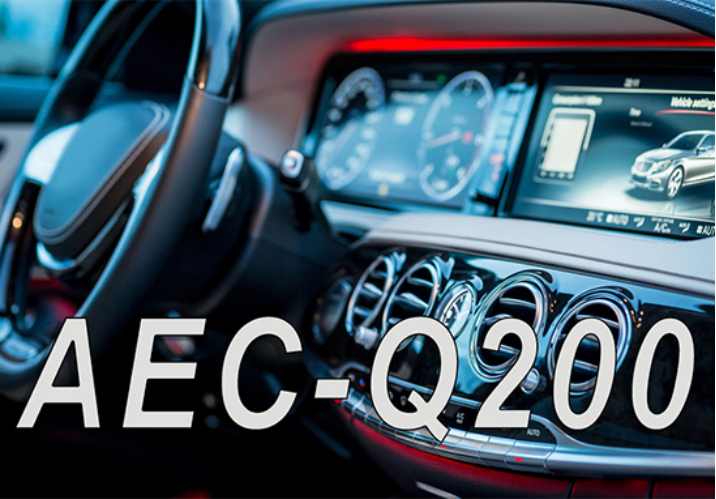Why automotive resistors, and inductors pass AEC-Q200 ?
Why must automotive-grade capacitors, resistors, and inductors pass AEC-Q200 certification?
With the rapid development of smart cars, passive components such as capacitors, resistors, and inductors are widely used in various electronic modules of the car. These passive components are responsible for various important functions of the vehicle, including controlling the engine, braking system, airbags, etc. Therefore, their reliability and quality are very important, as their failure can lead to dangerous situations in the vehicle. Reliability tests of such components often have problems such as project repeatability and inapplicability. Therefore, the automotive industry needs a refined standard to help OEMs and suppliers build a bridge of cooperation.
The AEC-Q200 testing standard for passive components specifies in detail the operating temperature range of passive components in various environments in the vehicle, and strictly distinguishes the test items of various components. Perfect regulations. It is a series of testing standards and requirements formulated by the Automotive Electronics Council (AEC) to ensure that the reliability and quality of automotive electronic components meet the requirements of automotive manufacturers and suppliers.

In AEC-Q200 certification, automotive-grade capacitors, resistors, and inductors need to go through a series of tests and verifications to ensure their reliability and quality meet the requirements of automotive manufacturers and suppliers.
Below we will introduce the common tests and verifications in AEC-Q200 certification in more detail.
The environmental test of AEC-Q200 is mainly formulated according to MIL-STD-202 and JEDEC22A-104 specifications. In addition to the different test temperatures of different parts, the requirements for the applied power supply (voltage, current, load) will also be different. , high-temperature storage does not apply bias and load, but it is required for high-temperature working life, temperature cycle and temperature shock, the purpose of the test is different from the method, the temperature change rate needs to be controlled in the temperature cycle, and the temperature shock is not used. High humidity is commonly known as high temperature and high humidity test, and humidity resistance is wet freezing test.
Notes on test conditions: 1000h test process needs to be measured at intervals of 250h and 500h
1. High temperature storage (MIL-STD-202-108):
[Applicable equipment: THS]
1. Film capacitor, network low-pass filter, network resistor, thermistor, variable capacitor, variable resistor, ceramic resonator, EMI interference suppressor, EMI interference filter: 85℃/1000h
2. Inductor, transformer, resistor: 125℃/1000h
3. Rheostat: 150℃/1000h
4. Tantalum capacitors, ceramic capacitors, aluminum electrolytic capacitors: maximum rated temperature/1000h
2. High temperature working life (MIL-STD-202-108):
[Applicable equipment: THS]
1. Network low-pass filter, network resistance: 85℃/1000h EMI
2. Interference suppressor, EMI interference filter: 85℃/1000h/apply rated IL
3. Tantalum capacitors, ceramic capacitors: maximum rated temperature/1000h/ (2/3) load/rated voltage
4. Aluminum electrolytic capacitors, inductors, transformers: 105℃/1000h
5. Film capacitor: 1000h/(85℃/125% rated voltage, 105℃&125℃/100% rated voltage)
6. Resettable fuse: 125℃/1000h
7. Resistor, thermistor, variable capacitor: 125℃/1000h/rated voltage
8. Variable resistor: 125℃/1000h/rated power
9. Rheostat: 125℃/1000h/rated voltage 85%+ma current
10. Ceramic resonator: 85℃/1000h/rated VDD+1MΩ, parallel inverter, 2X crystal CL capacitance between each crystal pin and ground
11. Quartz oscillator: 125℃/1000h/rated VDD+1MΩ, parallel inverter, 2X crystal CL capacitance between each crystal pin and ground
3. Temperature cycle (JEDEC22A-104):
[Applicable equipment: TSR, ESS]
1. Film capacitors, variable capacitors, variable resistors, ceramic resonators, EMI interference suppressors, EMI interference filters: -55°C (30min)←→85°C (30min)/RAMP (15°C/min)/1000cycles
2. Tantalum capacitors, ceramic capacitors, resistors, thermistors: -55°C (30min)←→125°C (30min) /RAMP (15°C/min)/1000cycles
3. Aluminum electrolytic capacitor: -40°C (30min)←→105°C (30min)/RAMP (15°C/min)/1000cycles
4. Inductors, transformers, rheostats, quartz oscillators, resettable fuses: -40°C (30min)←→125°C (30min)/RAMP (15°C/min)/1000cycles
5. Network low-pass filter, network resistance: -55°C (30min) ←→ 125°C (30min) /RAMP (15°C/min)/1000cycles
4. Temperature shock (MIL-STD-202-107):
[Applicable equipment: TC, TSK]
Resettable fuse: -40°C (15min) ←→ 125°C (15min)/300cycles
5. High humidity (MIL-STD-202-103):
[Applicable equipment: THS]
1. Tantalum capacitors, ceramic capacitors: 85℃/85%R.H./1000h/voltage 1.3~1.5V
2. Inductor & transformer: 85℃/85%R.H./1000h/without power
3. Aluminum electrolytic capacitor: 85℃/85%R.H./1000h/rated voltage
4. EMI interference suppressor, EMI interference filter: 85℃/85%R.H./1000h/rated voltage & current
5. Resistance, thermistor: 85℃/85%R.H./1000h/working power 10%
6. Resettable fuse: 85℃/85%R.H./1000h/rated current 10%
7. Variable capacitor and variable resistor: 85℃/85%R.H./1000h/rated power 10%
8. Network low-pass filter & network resistance: 85℃/85%R.H./1000h/voltage [network capacitance (rated voltage), network voltage
resistance (10% rated power)]
9. Rheostat: 85℃/85%R.H./1000h/rated voltage 85%+ma current
10. Quartz oscillator, ceramic resonator: 85℃/85%R.H./1000h/rated VDD+1MΩ, parallel inverter, 2X crystal CL capacitance between each crystal pin and ground
11. Film capacitor: 40℃/93%R.H./1000h/rated voltage
6. Humidity resistance (MIL-STD-202-106):
[Applicable equipment: THS]
1. Film capacitor: (25°C←→65°C/90%R.H.*2cycle)/18h→-10°C/3h, each cycle is 24h in total, step7a&7b are not powered.
In addition to the above tests, automotive-grade capacitors, resistors, and inductors also need to meet other requirements, such as size, capacitance value, resistance value, leakage current, inductance value, inductance loss, and so on. These requirements can ensure the quality and reliability of automotive-grade capacitors, resistors, and inductors, thereby ensuring the stability and safety of automotive electronic systems.
In conclusion, AEC-Q200 certification is one of the most important quality certifications in the field of automotive electronic components. Automotive-grade capacitors, resistors, and inductors are the most basic and commonly used three passive components in automotive electronic components. They need to be tested and verified by AEC-Q200 to ensure their reliability and quality meet the requirements of automotive manufacturers and suppliers. Require. In automotive electronic systems, these components play a very important role, so their quality and reliability are crucial to the safety and stability of the vehicle